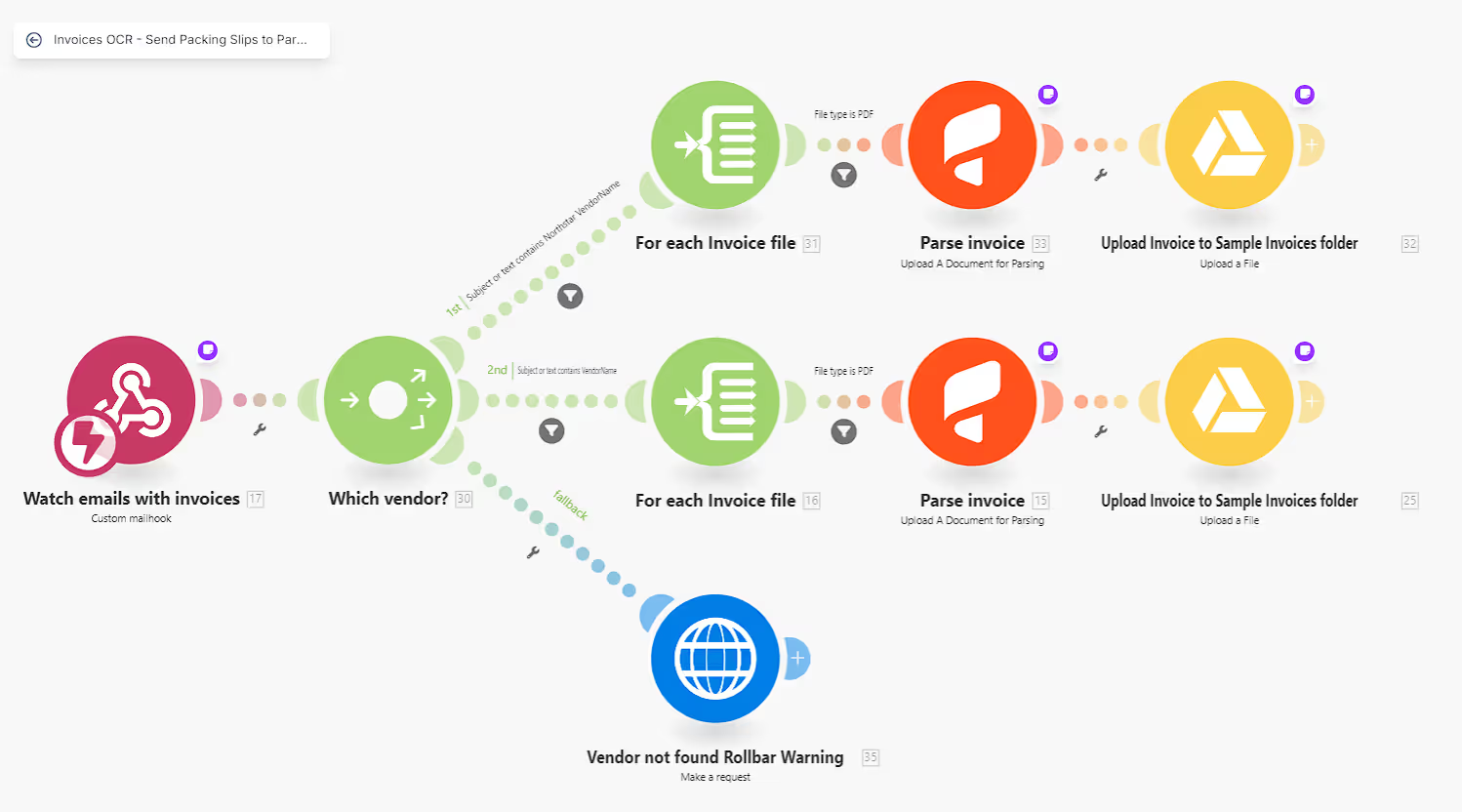Stop Typing PDFs: How Businesses Automate Data Entry with AI Parsing

If your business still relies on someone manually copying numbers from invoices, purchase orders, or packing slips into a spreadsheet, you’re not alone.
Most growing companies, even the tech-savvy ones, still spend hours each week retyping data that already exists somewhere in their inbox.
The problem isn’t just time. It’s accuracy, visibility, and scalability.
When information moves manually, things slip through the cracks: missing invoices, incorrect totals, mismatched client names. It’s small errors like these that quietly cost companies thousands every year.
The good news? You can finally stop typing.
From Manual Data Entry to AI Parsing
Over the past few years, we’ve seen an entire category of tools emerge to solve one universal headache, extracting structured information from unstructured files.
Whether it’s Docparser, Docsumo, Parseur, or Parsio, these AI-powered parsing tools can automatically read data from documents like invoices, receipts, lead forms, and contracts. They don’t just copy text, they recognize what that text means.
Where traditional OCR (Optical Character Recognition) tools only read words, modern AI parsers understand context. They know that “Invoice #4568” is an ID, that “Net 30” is a payment term, and that the number beside “Total Due” is the amount that matters.
That’s the key difference: OCR reads text; AI parsing reads meaning.
Why Businesses Are Adopting Parsing Tools Now
Until recently, document automation felt out of reach for most small and mid-sized businesses. It required developers, custom code, and expensive enterprise software.
Today, you can build a complete parsing and data-entry automation using no-code platforms like Make.com, Zapier, or Airtable Automations often in a matter of days.

At Atomic Actions, we integrate these parsing tools directly into client workflows. While we use several across different projects, Parsio has become our go-to choice because it plays nicely with our stack, connecting easily to Make.com, Airtable, QuickBooks, and custom apps via API. It’s reliable, flexible, and handles even complex document types through a mix of templates, AI models, and OCR.
This combination means businesses don’t need to choose between “off-the-shelf” convenience and “custom” power. They can get both, fast.
What a Parsing Workflow Looks Like in Real Life
Let’s say you’re a manufacturer or distributor. Each week, vendors send dozens of PDF packing slips to your inbox. Normally, someone would:
- Open each email
- Download the PDF
- Type product names, quantities, and totals into QuickBooks
- Check if products exist, add missing SKUs, and format the invoice
That’s hours of repetitive admin every week.
With an automated parsing workflow, that same process happens in the background:
- Email arrives with a PDF attached.
- The parser reads and extracts key fields: vendor name, invoice total, product details.
- AI cleans and formats the data to match your system’s structure.
- A review step appears in your dashboard: a team member quickly checks and approves the parsed data before it’s finalized.
- Once approved, the information is sent automatically to QuickBooks or your CRM through Make.com.
- A chat or email notification confirms the record was created and filed.
Everything happens in under a minute. No one retypes anything.

Real-World Example: Invoicing Automation in Manufacturing
One of our clients, X-Cel Technologies, is a CNC manufacturer & electronics distributor. Their billing team used to spend up to 15 minutes per invoice retyping data into QuickBooks. With hundreds of shipments each month, invoicing delays were hurting cash flow.
We built them a fully automated no-code invoice automation system using Parsio, ChatGPT API, and QuickBooks. The system reads packing slips directly from email, validates the data, creates invoices automatically, and attaches the original PDF for traceability.
The results:
- 15× faster invoice creation
- 3× more invoices processed with the same team
- 100% elimination of manual data entry
And just as important, their finance team doesn’t even think about invoicing anymore. It happens quietly in the background.
AI Parsing Beyond Invoices
While invoicing is a clear win, it’s far from the only use case. Parsing workflows can be implemented for:
- Medical documents: automatically identify key information: patient name, date of consultation, diagnosis, prescribed treatments, lab test results.
- Food lab results: process incoming lab results of food safety and compliance in PDFs directly from email, intelligently extract and structure the data.
- Client onboarding forms: turning form submissions into CRM records and projects automatically.
- Lead emails: extracting contact details from inbound leads or quote requests.
- Payroll and compliance docs: reading scanned forms, validating data, and routing them for approval.
- Contracts and reports: parsing key information like dates, addresses, and totals for searchable archives.
- Real estate operations: reading property data, contracts, and ID documents to reduce admin time.
Essentially, anywhere your team moves data between files and systems, parsing can help.
When You Shouldn’t Automate Parsing (Yet)
Not every workflow is ready for AI parsing out of the box.
If the source data is messy, different formats, missing fields, or inconsistent naming, the parser will struggle too.
That’s why, before we automate anything, we start with operational discovery, mapping out how documents actually flow through your business. Once we know what’s consistent and what’s not, we can design a workflow that’s both accurate and scalable.
Read more about: Operational Discovery & Business Automation Audits.
Sometimes that means cleaning up templates, adding standard file naming rules, or clarifying who owns each step.
It’s a little extra work upfront, but it’s what makes automation stable in the long run.
The Real ROI: Clean Data, Faster Decisions
When parsing tools handle data entry, every record comes in clean, complete, and formatted exactly how your system expects. That consistency creates ripple effects: fewer errors in reports, faster reconciliations, and better decision-making.
In many of our SMEs projects, automating document parsing leads to:
- 20–40 hours saved monthly in admin work
- Fewer manual errors across accounting and CRM
- Faster billing cycles, improving cash flow
- Happier teams, freed from repetitive work
It’s not about replacing people. It’s about letting your team focus on value, not copy-paste.
With the right mix of parsing tools and automation platforms, every document that lands in your inbox can instantly update your CRM, accounting tool, or database.
Ready to Stop Typing?
Whether you’re processing invoices, onboarding new clients, or managing real estate paperwork your data entry shouldn’t rely on humans anymore.
Atomic Actions helps SMEs and growing businesses design and build automated workflows that connect tools like Parsio, Make, Google Sheets, Airtable, and QuickBooks and any CRM you use into one seamless flow.
Most of these projects take days, not months, and start paying off immediately in time saved and errors avoided.
If your team spends hours retyping information that already exists somewhere else, it’s time to fix it.






%20(1).avif)
.avif)





